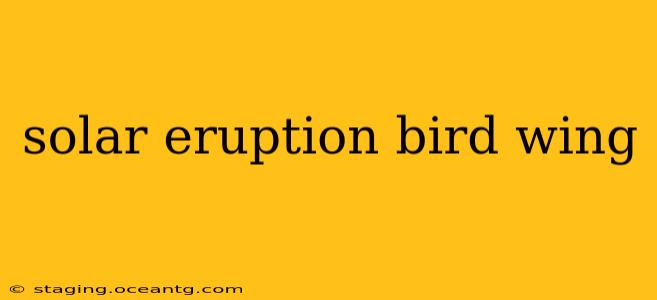The sun, a seemingly distant star, and the delicate wings of a bird might seem worlds apart. However, the impact of solar eruptions, powerful bursts of energy from the sun, can surprisingly affect avian life, particularly through their influence on Earth's atmosphere and magnetic field. This article explores the fascinating, albeit indirect, relationship between solar eruptions and bird wing function, addressing common questions surrounding this intriguing topic.
How Do Solar Eruptions Affect Birds?
Solar eruptions, including solar flares and coronal mass ejections (CMEs), release massive amounts of energy into space. This energy interacts with Earth's magnetosphere, causing geomagnetic storms. These storms can disrupt various systems on Earth, including navigation systems used by some birds. Many migratory birds rely on the Earth's magnetic field for navigation, and geomagnetic storms can interfere with their internal compasses, potentially leading to disorientation and navigational errors. This disruption could theoretically affect their flight patterns and even cause them to expend more energy, potentially impacting wing function through fatigue.
Can Solar Eruptions Damage Bird Wings Directly?
No, solar eruptions do not directly damage bird wings. The energy released during a solar eruption is mostly in the form of electromagnetic radiation (light, X-rays, etc.) and charged particles. While intense solar flares can affect the Earth's ionosphere, the levels of radiation reaching the surface are not strong enough to cause direct physical damage to bird wings. The impact is indirect, influencing their navigation and potentially their flight efficiency.
What is the Effect of Geomagnetic Storms on Bird Migration?
Geomagnetic storms, triggered by solar eruptions, are believed to influence bird migration by disrupting their magnetic sense. Studies have shown that birds' ability to detect and orient themselves using the Earth's magnetic field can be affected during geomagnetic disturbances. This disruption might lead to deviations from their usual migratory routes, increased energy expenditure, and potentially longer migration times. The increased energy expenditure could, over time, place more stress on their wings, but this would not be a direct effect of the solar eruption itself.
Do Birds Show Behavioral Changes During Solar Storms?
While more research is needed, some studies suggest that birds may exhibit behavioral changes during geomagnetic storms. These changes could manifest in altered flight patterns, increased restlessness, or changes in their migratory timing. However, it's crucial to distinguish between the effects of geomagnetic storms and other environmental factors that could also influence bird behavior. The complexity of bird migration and the many variables involved make it challenging to definitively isolate the effects of solar eruptions.
How Do Scientists Study the Impact of Solar Eruptions on Birds?
Researchers employ various methods to investigate the connection between solar eruptions and bird behavior. These methods include tracking birds' movements using GPS tags, analyzing bird migration data in relation to periods of high solar activity, and conducting laboratory experiments to study the effects of magnetic fields on birds' navigational abilities. By combining these approaches, scientists can gain a deeper understanding of the complex interplay between solar activity, geomagnetic disturbances, and avian migration.
Conclusion:
While solar eruptions don't directly harm bird wings, their indirect effects on Earth's magnetic field can significantly impact avian navigation and possibly their flight efficiency. Geomagnetic storms can disrupt birds' internal compasses, leading to navigational errors and potentially increased energy expenditure during migration. The research into this fascinating intersection of solar physics and avian biology is ongoing, revealing more about the delicate balance of nature and the far-reaching influence of our sun. Further research promises to unveil more intricate details of this complex relationship.
